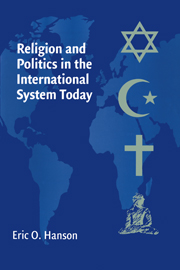Book contents
- Frontmatter
- Contents
- Acknowledgments
- Religion and Politics in the International System Today
- Introdution: The view from Silicon Valley
- I RELIGION AND POLITICS IN THE NEW GLOBAL PARADIGM
- II RELIGION IN CONTEMPORARY WORLD POLITICS
- 5 The West: Christianity, Secularization, and Immigration
- 6 East Asia: Modernization and Ideology
- 7 South and Central Asia: The Legacies of Gandhi and Khomeini and the Bomb
- 8 The Middle East and North Africa: Jewish and Islamic Politics
- 9 Latin America: Indigenous Religions, Christianity, and Globalization
- 10 Religion and Politics for the Next Millennium
- Appendix I Thirty Years of Nobel Peace Prizes, 1975–2004
- Appendix II Paradigm Chart and Category Questions
- Index
10 - Religion and Politics for the Next Millennium
Published online by Cambridge University Press: 06 January 2010
- Frontmatter
- Contents
- Acknowledgments
- Religion and Politics in the International System Today
- Introdution: The view from Silicon Valley
- I RELIGION AND POLITICS IN THE NEW GLOBAL PARADIGM
- II RELIGION IN CONTEMPORARY WORLD POLITICS
- 5 The West: Christianity, Secularization, and Immigration
- 6 East Asia: Modernization and Ideology
- 7 South and Central Asia: The Legacies of Gandhi and Khomeini and the Bomb
- 8 The Middle East and North Africa: Jewish and Islamic Politics
- 9 Latin America: Indigenous Religions, Christianity, and Globalization
- 10 Religion and Politics for the Next Millennium
- Appendix I Thirty Years of Nobel Peace Prizes, 1975–2004
- Appendix II Paradigm Chart and Category Questions
- Index
Summary
This chapter brings together conclusions from throughout the book to recommend future international political-religious policy. First, since no paradigm has ever offered the definitive understanding of even natural science, let alone global politics, what are the advantages and the limitations of the paradigm employed by this text? Second, the interaction between religion and politics constitutes the second plane of the paradigm. How do the three factors of the level of interaction, the nature of the religion, and the regional or national form of political-religious interaction help explain current international politics? Third, the book divided seven world religions into three types: religions of the book, religions of meditative experience, and religions of public life. How do these types influence each other religiously and politically, especially at the regional and global levels? Fourth, what are the most crucial international political alliances which could best serve world peace, justice, and order in the twenty-first century? What interfaith dialogues would be helpful for these alliances? Finally, “Is religion good or bad for politics?” If, “Both,” the more specific question becomes, “Under what circumstances does mostly good result?”
THE NEW PARADIGM FOR CONTEMPORARY POLITICS: ADVANTAGES AND LIMITATIONS
Few foreign affairs pundits predicted the rise of democratic forces in Poland, Czechoslovakia, Hungary, and East Germany that led to the fall of the Berlin Wall. Academics more easily foresee relatively minor adjustments in the political and EMC systems.
- Type
- Chapter
- Information
- Religion and Politics in the International System Today , pp. 295 - 324Publisher: Cambridge University PressPrint publication year: 2006



